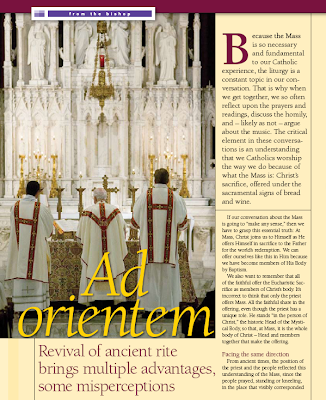“
W
hen we study the most ancient liturgical practices of the Church, we find that the priest and the people faced in the same direction, usually toward the east, in the expectation that when Christ returns, He will return from the east."This quote comes from the most recent edition of the Eastern Oklahoma Catholic where Bishop Edward Slattery of the diocese of Tulsa speaks on the subject of ad orientem and his restoration of that long-standing practice in his own cathedral church.

Bishop Slattery's consideration extends also to a consideration of the consequences of the shift to versus populum:
An innovation with unforeseen consequences
In the last 40 years, however, this shared orientation was lost; now the priest and the people have become accustomed to facing in opposite directions. The priest faces the people while the people face the priest, even though the Eucharistic Prayer is directed to the Father and not to the people.
This innovation was introduced after the Vatican Council, partly to help the people understand the liturgical action of the Mass by allowing them to see what was going on, and partly as an accommodation to contemporary culture where people who exercise authority are expected to face directly the people they serve, like a teacher sitting behind her desk. Unfortunately this change had a number of unforeseen and largely negative effects. First of all, it was a serious rupture with the Church’s ancient tradition. Secondly, it can give the appearance that the priest and the people were engaged in a conversation about God, rather than the worship of God. Thirdly, it places an inordinate importance on the personality of the celebrant by placing him on a kind of liturgical stage.
Bishop Slattery continues:
Recovering the sacred
Even before his election as the successor to St. Peter, Pope Benedict has been urging us to draw upon the ancient liturgical practice of the Church to recover a more authentic Catholic worship. For that reason, I have restored the venerable ad orientem position when I celebrate Mass at the Cathedral. This change ought not to be misconstrued as the Bishop “turning his back on the faithful,” as if I am being inconsiderate or hostile. Such an interpretation misses the point that, by facing in the same direction, the posture of the celebrant and the congregation make explicit the fact that we journey together to God. Priest and people are on
this pilgrimage together.
Needless to say, it would be well worth your time to read the entire article.
(Thanks to a reader for sending this in.)
